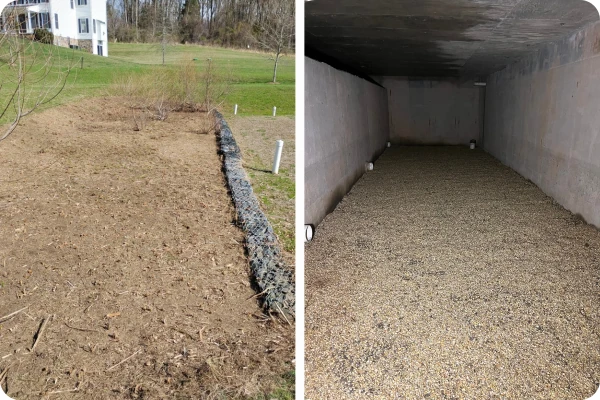When it comes to controlling stormwater runoff and protecting local waterways, sand filters are one of the most dependable – and underappreciated – solutions available. While they may not get the spotlight like rain gardens or green roofs, sand filters quietly and effectively remove pollutants from runoff in commercial, industrial, and urban settings.
In this post, we’ll explore how sand filters work, where they’re used, and why they’re a smart investment for long-term stormwater compliance and environmental protection.

What Is a Sand Filter in Stormwater Management?
A stormwater sand filter is an engineered structure designed to remove sediment, oils, nutrients, and other pollutants from runoff before that water reaches local waterways or the storm drain system. Unlike natural filters (such as vegetated swales), sand filters rely on layers of sand and gravel to trap contaminants as water flows through the system.
These systems are often installed in parking lots, commercial developments, and high-density urban areas where large volumes of runoff from impervious surfaces need to be treated efficiently.
How Do Sand Filters Work?
Sand filters operate using a multi-stage treatment process:
- Pretreatment – Stormwater first enters a sedimentation or forebay chamber, where heavy debris and grit settle out.
- Filtration – Water then moves slowly through a bed of sand, which acts as a physical and chemical filter. Pollutants are removed through processes like straining, adsorption, and microbial action.
- Outlet or Infiltration – Cleaned water either drains into a storm sewer, is released into the environment, or infiltrates into the ground, depending on the system design.
This combination of mechanical and biological treatment makes sand filters ideal for sites that require reliable pollutant removal without complicated technology.
What Do Sand Filters Remove from Runoff?
Sand filters are highly effective at capturing:
- Suspended solids
- Nutrients like phosphorus and nitrogen
- Heavy metals
- Bacteria (including fecal coliform)
- Oil and grease
- Trash and floatables
Because they are so versatile, sand filters are frequently used to meet municipal and state stormwater permit requirements, especially under MS4 or NPDES Phase I and II programs.
Where Are Sand Filters Most Commonly Installed?
Sand filters can be adapted to fit many environments, but they’re especially beneficial in:
- Urban redevelopment sites with limited space
- Large commercial parking lots
- Industrial facilities with high pollutant loads
- Dense residential neighborhoods
- Areas near impaired waterways that require additional pollutant load reduction
Designs can be above ground, below ground, or perimeter-based, depending on site constraints and goals.
Advantages of Sand Filters for Property Managers & Developers
Property owners who invest in sand filter systems can benefit from:
✅ Regulatory compliance with stormwater discharge permits
✅ Improved site aesthetics (with aboveground systems)
✅ Long-term cost savings through pollutant load reduction
✅ Protecting local water resources and public health
✅ Increased property value due to sustainable design features
In addition, sand filters are relatively low-tech and low-maintenance, which means fewer headaches over time – especially when a professional service partner handles routine inspections and cleanings.
Best Practices for Long-Term Sand Filter Performance
To keep your sand filter functioning at peak efficiency:
- Inspect regularly – especially after major storms
- Rake the sand surface to prevent crusting
- Remove trash, sediment, and leaf litter from the surface
- Replace sand as needed – typically every few years depending on load
- Keep inlet and outlet structures clear
Working with an experienced provider like iSTORMWATER ensures that these tasks are done correctly and on schedule – keeping your system compliant and your water clean.
Sand Filters vs. Other Stormwater Solutions
While biofilters, detention ponds, and green infrastructure all play valuable roles in runoff management, sand filters stand out in environments where:
- Space is limited
- High pollutant removal is required
- Visual access to the system is important for inspections
- Underground options are preferred for aesthetics or zoning
In many cases, sand filters are part of a broader stormwater management strategy, working alongside other BMPs to protect downstream water quality.
Final Thoughts
Whether you manage a large commercial site or are planning a new development, sand filters offer a durable, cost-effective way to meet environmental obligations while protecting your property and the surrounding community. With proper design and maintenance, they can serve your site for decades to come.
If you’re ready to explore sand filters for your next project – or need professional maintenance on an existing system – contact the experts at iSTORMWATER. We help property managers, developers, and owners across Maryland, Virginia, D.C., and Delaware navigate stormwater compliance with ease.
Need help with sand filter maintenance or inspections?
📞 Call us at (410) 231-3455 or contact us online to schedule a consultation.
Real Results
iStormwater LLC was an excellent choice. They made the process of the Stormwater pond repairs seamless. They took charge of the project and got the project approved and passing the inspection. We highly recommend them and would use them again.
Incredible stormwater management service. The owner John consulted on a property I manage and ended up saving us thousands of dollars in environmental fees from the government. Now, our property is compliant with the EPA and we have a great partner to keep us maintained on stormwater regulations over time.
So helpful with all of my water issues.
Great communication and leadership and a family friendly atmosphere. Thank you John!
Stormwater management systems are essential for protecting your property, surrounding infrastructure, and local waterways from flooding, erosion, and pollution. But like any infrastructure, these systems...
- Annapolis
- Anne Arundel County
- Baltimore County
- Baltimore
- Bel Air South
- Bethesda
- Bowie
- Cecil County
- Charles County
- Columbia
- Gaithersburg
- Glen Burnie
- Howard County
- Montgomery County
- Pasadena
- Prince George’s County
- Rockville
- Severna Park
- St. Mary’s County



